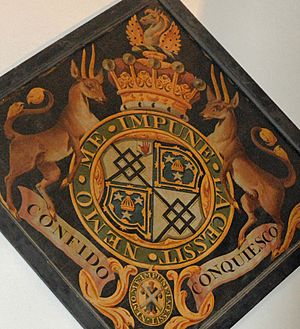Earl of Dysart facts for kids
Quick facts for kids Earldom of Dysart |
|
|---|---|

|
|
| Creation date | 3 August 1643 |
| Monarch | King Charles I |
| Peerage | Peerage of Scotland |
| First holder | William Murray |
| Present holder | John Peter Grant of Rothiemurchus, 13th Earl |
| Heir apparent | James Patrick Grant, Lord Huntingtower |
| Remainder to | 2nd Countess's heirs of the body lawfully begotten, failing which to her heirs whatsoever |
| Subsidiary titles | Lord Huntingtower |
The Earl of Dysart (pronounced DYE-zert) is a special title in Scotland. King Charles I created this title in 1643 for William Murray. Since then, his family members have held the title without interruption.
Contents
How the Title Started
The title was given in 1643 to William Murray. He was also made Lord Huntingtower at the same time. Both of these are Scottish titles. William Murray was a close friend of King Charles I for his whole life. In fact, when Charles was a prince, William was his whipping boy. A whipping boy was a child who was punished when the prince did something wrong. This was because it was not allowed to punish a prince directly.
Who Inherited the Title
William Murray's daughter, Elizabeth, became the 2nd Countess after him. In 1670, she gave up the title and then received it back with special rules for who could inherit it next. This meant her children would inherit it, and if not, then other family members.
Elizabeth married Sir Lionel Tollemache, 3rd Baronet first. She later married John Maitland, 1st Duke of Lauderdale. Her son from her first marriage, Lionel, became the 3rd Earl. He also inherited his father's title as the 4th Baronet.
When the 3rd Earl died, his grandson, Lionel, became the 4th Earl in 1727. The title then passed to the 4th Earl's oldest son, Lionel, in 1770. The 5th Earl had no children, so his brother, Wilbraham, became the 6th Earl in 1799.
When Wilbraham died in 1821, he had no direct children. So, his sister, Louisa Tollemache, became the 7th Countess. She was 75 years old. She changed her last name to Tollemache to keep the family name.
Louisa's grandson, Lionel, became the 8th Earl in 1840. He had also inherited his father's Baronet title. When the 8th Earl died in 1878, his grandson, William, became the 9th Earl.
After the 9th Earl died, the Baronet title and the Scottish Earldom went to different people. The Baronet title went to a male relative, Lyonel. But the Earldom went to the 9th Earl's niece, Wynefryde Agatha, who became the 10th Countess in 1935.
Wynefryde was followed by her oldest daughter, Rosamund Agnes Greaves, who became the 11th Countess in 1975. In 2003, Rosamund's sister, Katherine Grant of Rothiemurchus, became the 12th Countess.
Today, the title is held by Katherine's only son, John Peter Grant of Rothiemurchus. He became the 13th Earl in 2011. The family's main home is now The Doune of Rothiemurchus, which is near Aviemore in Inverness-shire, Scotland.
Earls and Countesses of Dysart (since 1643)
- 1643: William Murray, 1st Earl of Dysart (around 1600–1655)
- 1655: Elizabeth Tollemache, 2nd Countess of Dysart (1626–1698)
- 1698: Lionel Tollemache, 3rd Earl of Dysart (1649–1727)
- 1727: Lionel Tollemache, 4th Earl of Dysart (1708–1770)
- 1770: Lionel Tollemache, 5th Earl of Dysart (1734–1799)
- 1799: Wilbraham Tollemache, 6th Earl of Dysart (1739–1821)
- 1821: Louisa Tollemache, 7th Countess of Dysart (1745–1840)
- 1840: Lionel William John Tollemache, 8th Earl of Dysart (1794–1878)
- 1878: William John Manners Tollemache, 9th Earl of Dysart (1859–1935)
- 1935: Wenefryde Agatha Scott, 10th Countess of Dysart (1889–1975)
- 1975: Rosamund Agnes Greaves, 11th Countess of Dysart (1914–2003)
- 2003: Katherine Grant of Rothiemurchus, 12th Countess of Dysart (1918–2011)
- 2011: John Peter Grant of Rothiemurchus, 13th Earl of Dysart (born 1946)
The person expected to inherit the title next is the current Earl's only son, James Patrick Grant of Rothiemurchus, Lord Huntingtower (born 1977). The person expected to inherit after James is his son, John Peter Grant of Rothiemurchus, Master of Huntingtower (born 2011).
See also
- Baron Tollemache
- Tollemache baronets
- Tollemache family

